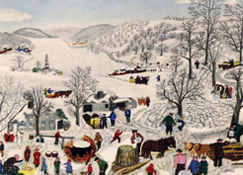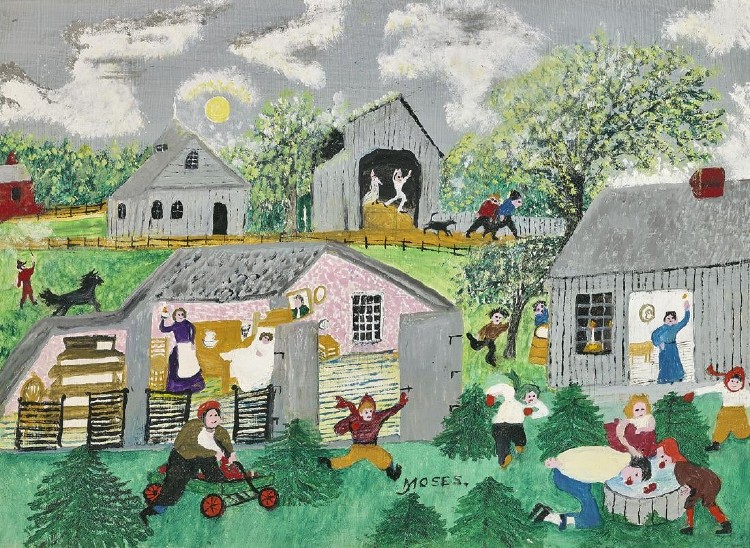
NEW YORK – To appreciate Grandma Moses, you only need to take a step back 100 years. “The old lady as an artist and the artist as American,” was how Anna Mary Robertson Moses was described in the documentary Grandma Moses produced in 1950 when she was 90. “The truth is, though, she was old lady first and artist after,” the documentary continued, a depiction that pleased her.
At 78, when most her age were finally settling in with grandkids, Grandma Moses started painting because arthritis kept her from her embroidery and it was easier on her hands, as the official story is told. According to what she told reporters later on, however, painting was “easier to make than to bake a cake over a hot stove.” And the paintings would last longer than the worsted wool embroidery anyway, she insisted. It was also comforting and relaxing to paint, something an older person could easily do, she suggested in a later interview.
It wasn’t necessarily the painting she was drawn to, it was the memories of a long life well lived. Born in 1860, about five months before the firing on Fort Sumter that began the Civil War, Anna Mary Robertson was the third of 10 children in a farm family in Greenwich, New York. At 12 she was sent as a domestic to a neighboring farm but still managed to make “landscapes” with whatever was handy, even if she had to make the ‘paint’ from lemons or grapes herself. For the rest of her life she was the same practical farm wife in rural Shenandoah Valley in Virginia and upstate New York, finally settling in Eagle Bridge, a still rural area in New York state not far from the New Hampshire border.
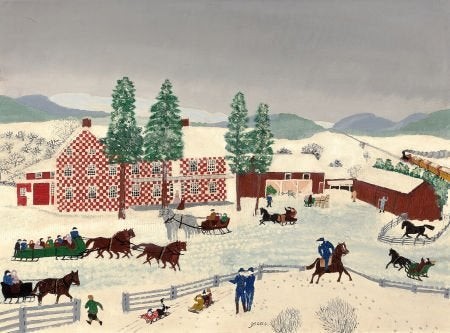
While married to Thomas Salmon Moses, Anna Mary had 10 children (five that survived into adulthood), made and sold potato chips, embroidered cards made of yarn and mosquito netting, quilted, churned butter, milked cows, baked pies, put up preserves for the county fair and helped around the farm as a wife was expected to do. It was a quiet, rural life of husband, “…horses and children, of sleds and sleighs, of visiting and traveling, of arrivals and departures, of families and feasts…”, as the documentary attests. Walter Moses died at age 67 in 1936 and she never remarried, instead retiring with a daughter when she was 76 at her farm in Hoosick Falls, New York, just south of Eagle Bridge. Not long after, painting became her full-time “hobby art.”
At first, her paintings were simplistic images or copied from something she particularly liked. Later, the paintings took on the very rural panorama of color, people, horses and the quiet life as she tended to remember it or imagine it. Asked how she painted, she replied that she painted down, meaning she painted the sky first, the trees next, then the ground last. And she used whatever was handy such as house paint on cut fireboards. Art critic Lucy Lippard would later be wonderfully amazed at her innate ability to make “hobby art” something of wonder only from scraps and leftovers.
Grandma Moses, a nickname given to her by the press, is credited with about 1,500 paintings representing all aspects of rural life over two dozen years, from her first paintings sold at the age of 78 (in an exhibition titled “What a Farm Wife Painted” in 1938) until her death at 101. Not in any of them are modern things like telephone poles or mechanized farm equipment such as tractors. The only motorized vehicle was usually an early ‘horseless carriage’ such as her painting on wood in 1944 titled The Old Automobile showing a 1913 open-air sedan scaring the horses of a farm carriage as it drove past at a noisy fury and at great speed. Moses didn’t care for that.
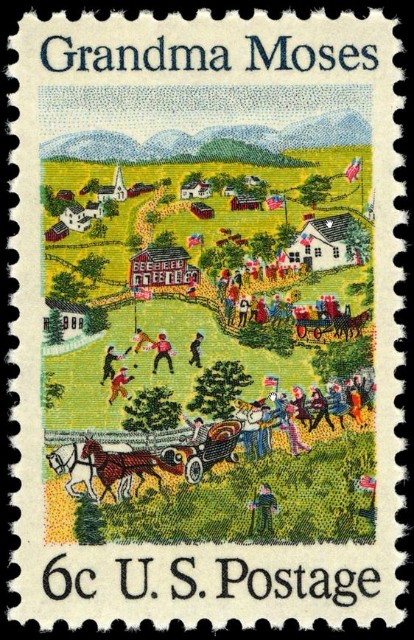
“There are painters Grandma Moses knows who paints trouble; their pigs break out of the sties and their horses scrabble the traces and nobody wants to look at them. Grandma Moses’ pigs are where they belong and horses behave as horses should unless city people with automobiles upset them,” the documentary noted.
All artful perspective in the paintings of Grandma Moses just wasn’t a consideration at all. The color, the expressions, the busy landscape, the scene itself was what mattered and still does to collectors. Her paintings were once described as being of “curious charm, not childlike, but like the scenes of a child.”
The painting titled Sugaring Off, for example, emphasized this busy landscape approach. This winter painting, ones she particularly enjoyed recreating the most, showed a community harvesting maple syrup from trees with children playing, adults working hard, fires burning, caldrons being stirred and oxen pulling carriages depicting as much activity as can be expected at a real ‘sugaring off’ event. Naturally, none of the activity even pretends to be proportional or with perfect perspective, but it is lively, colorful and interesting nonetheless. In 2006, the original painting on wood sold at auction for $1.2 million, the highest paid for a Grandma Moses original at the time.

As with many prominent artists, the paintings of fireboard and house paint that Grandma Moses found around the house hang prominently in many of the world’s foremost museums including the Museum of Modern Art, the Smithsonian American Art Museum, the National Museum of Women in the Arts, and especially the Bennington Museum in Bennington, Vermont, which holds the largest collection of Grandma Moses original artwork. Even the White House features her Fourth of July as part of its permanent collection, which was also the basis for a U.S. Post Office commemorative 6-cent stamp honoring Grandma Moses in 1969.
Her earlier paintings were sold out of her home for $3 to $5, depending on size, just as she earlier sold potato chips for additional household income. Later, Edward R. Murrow was delighted in an interview when she was 95 when he asked her if she ever regretted selling a painting she spent so much time on. She lively replied as a farmer’s wife would, “No. I’d rather have the money.” Collectors today, though, are only able to find an original signed Grandma Moses at auction from $4,200 for A Snow Scene to $110,000 for The Old Checkered House, a far cry from her earlier “butter and egg” money sales.
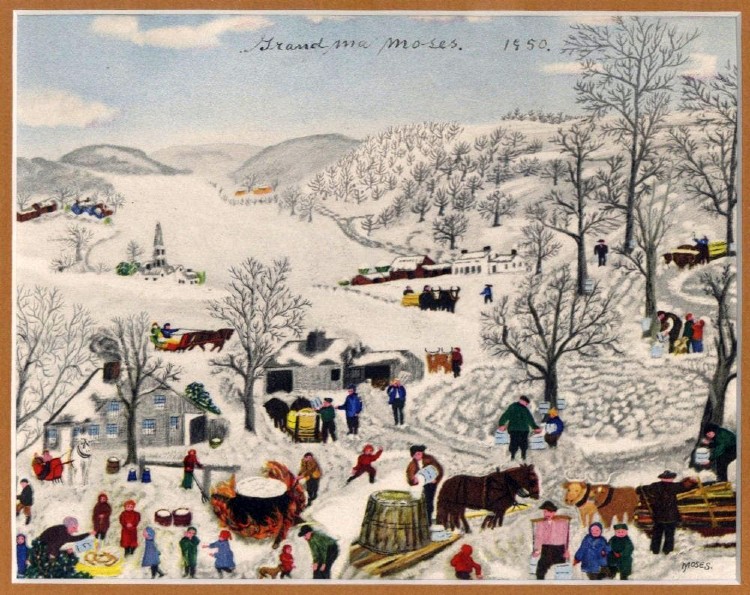
So it isn’t surprising then to find that the paintings of Grandma Moses are readily reproduced on cards, collector plates, posters, mugs and all manner of commemorative items found at auction. This only reinforces the popularity of the simple, country landscape scenes remembered or imagined by Grandma Moses as a nostalgic counterpoint of an earlier era to the ever-increasing hustle and bustle of modern life. Yet, in a radio interview in 1952 when she was 92, she was asked if she would like to go back to live in the time of stagecoaches again. “No, I don’t care to go back. I like to go forward. Never lose faith in the future,” she added.
Grandma Moses died in 1961 at the age of 101 in Hoosick Falls, New York, a beloved painter of “hobby art” who still inspires, is still appreciated, and will always be fondly remembered as one who went forward with the simple past firmly painted in colorful imagination. Not old, just an American artist.


